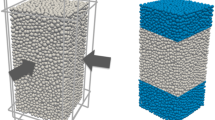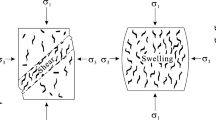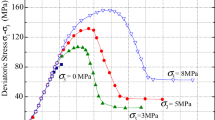Abstract
A discrete approach is proposed to study damage and failure processes taking place in argillaceous rocks which present a transversely isotropic behavior. More precisely, a dedicated discrete element method is utilized to provide a micromechanical description of the mechanisms involved. The purpose of the study is twofold: (1) presenting a three-dimensional discrete element model able to simulate the anisotropic macro-mechanical behavior of the Callovo-Oxfordian claystone as a particular case of argillaceous rocks; (2) studying how progressive failure develops in such material. Material anisotropy is explicitly taken into account in the numerical model through the introduction of weakness planes distributed at the interparticle scale following predefined orientation and intensity. Simulations of compression tests under plane-strain and triaxial conditions are performed to clarify the development of damage and the appearance of shear bands through micromechanical analyses. The overall mechanical behavior and shear banding patterns predicted by the numerical model are in good agreement with respect to experimental observations. Both tensile and shear microcracks emerging from the modeling also present characteristics compatible with microstructural observations. The numerical results confirm that the global failure of argillaceous rocks is well correlated with the mechanisms taking place at the local scale. Specifically, strain localization is shown to directly result from shear microcracking developing with a preferential orientation distribution related to the orientation of the shear band. In addition, localization events presenting characteristics similar to shear bands are observed from the early stages of the loading and might thus be considered as precursors of strain localization.















Similar content being viewed by others
References
Andra D (2005a) Dossier Argile: Synthesis—evaluation of the feasibility of a geological repository in an Argillaceous formation, Meuse/Haute Marne Site. Technical Report Paris, France
Andra D (2005b) Dossier: Référentiel du site Meuse/Haute-Marne Tome 2: Caractérisation comportementale du milieu géologique sous perturbation, 2nd edn. Paris, France
Armand G, Noiret A, Zghondi J, Seyedi DM (2013) Short- and long-term behaviors of drifts in the Callovo-Oxfordian claystone atthe Meuse/Haute-Marne Underground Research Laboratory. J Rock Mech Geotech Eng 5:221–230
Armand G, Leveau F, Nussbaum C, de La Vaissiere R, Noiret A, Jaeggi D, Landrein P, Righini C (2014) Geometry and Properties of the Excavation-Induced Fractures at the Meuse/Haute-Marne URL Drifts. Rock Mech Rock Eng 47(1):21–41
Bésuelle P, Hall SA (2011) Characterization of the strain localization in a porous rock in plane strain condition using a new true-triaxial apparatus. In: Bonelli S, Dascalu C, Nicot F (eds) Advances in bifurcation and degradation in geomaterials. Springer series in geomechanics and geoengineering. Springer, Berlin
Cho JW, Kim H, Jeon S, Min KB (2012) Deformation and strength anisotropy of Asan gneiss, Boryeong shale, and Yeoncheon schist. Int J Rock Mech Min Sci 50:158–169
De Borst R, Sluys LJ, Mulhaus HB, Pamin J (1993) Fundamental issues in finite element analyses of localization of deformation. Eng Comp 10(2):99–121
Debecker B, Vervoort A (2013) Two-dimensional discrete element simulations of the fracture behaviour of slate. Int J Rock Mech Min Sci 61:161–170
Desbois G, Höhne N, Urai JL, Bésuelle P, Viggiani G (2017) Deformation in cemented mudrock (Callovo-Oxfordian Clay) by microcracking, granular flow and phyllosilicate plasticity: insights from triaxial deformation, broad ion beam polishing and scanning electron microscopy. Solid Earth 8:291–305
Ding X, Zhang L (2014) A new contact model to improve the simulated ratio of unconfined compressive strength to tensile strength in bonded particle models. Int J Rock Mech Min Sci 69:111–119
Duan K, Kwok C (2016) Evolution of stress-induced borehole breakout in inherently anisotropic rock: insights from discrete element modeling. J Geophys Res Solid Earth 121:2361–2381
Duan K, Kwok C, Pierce M (2015) Discrete element method modeling of inherently anisotropic rocks under uniaxial compression loading. Int J Numer Anal Meth Geomech. https://doi.org/10.1002/nag.2476
Eijnden AP, Bésuelle P, Chambon R, Collin F (2016) A FE2 modelling approach to hydromechanical coupling in cracking-induced localization problems. Int J Solids Struct 97–98:475–488
GL-Mouv (2016) Réunion plénière du GL MOUV, ANDRA
Guo P (2012) Critical length of force chains and shear band thickness in dense granular materials. Acta Geotech 7(1):42–55
Hu D, Zhang F, Shao JF (2014) Experimental study of poromechanical behavior of saturated claystone under triaxial compression. Acta Geotech 9:207–214
Lenoir N, Bornert M, Desrues J, Bésuelle P, Viggiani C (2007) Volumetric digital image correlation applied to X-ray microtomography images from triaxial compression tests on argillaceous rock. Strain 43(3):193–205
Lisjak A, Tatone BSA, Grasselli G, Vietor T (2014) Numerical Modelling of the Anisotropic Mechanical Behaviour of Opalinus Clay at the Laboratory-Scale Using FEM/DEM. Rock Mech Rock Eng 47:187–206
Lisjak A, Tatone B, Mahabadi OK, Grasselli G, Marschall P, Lanyon GW, de la Vaissie`re R, Shao H, Leung H, Nussbaum C (2016) Hybrid Finite-Discrete Element Simulation of the EDZ Formationand Mechanical Sealing Process Around a Microtunnel in Opalinus Clay. Rock Mech Rock Eng 49:1849–1873
Mars Ivars D, Pierce ME, Darcel C, Reyes-Montes J, Potyondy DO, Young RP, Cundall PA (2011) The synthetic rock mass approach for jointed rock mass modelling. Int J Rock Mech Min Sci 48(2):219–244
Menaceur H, Delage P, Tang AM, Conil N (2015) The thermo-mechanical behaviour of the Callovo-Oxfordian claystone. Int J Rock Mech Min Sci 78:290–303
Menaceur H, Delage P, Tang AM, Conil N (2016) On the thermo-hydro-mechanical behaviour of a sheared Callovo-Oxfordian claystone sample with respect to the EDZ behaviour. Rock Mech Rock Eng 49:1875–1888
Niandou H, Shao J, Henry J, Fourmaintraux D (1997) Laboratory investigation of the mechanical behavior of Tournemire argilite. Int J Rock Mech Min Sci 34:3–16
Pardoen B, Seyedi DM, Collin F (2015) Shear banding modelling in cross-anisotropic rocks. Int J Solids Struct 72:63–87
Park B, Min KB (2015) Bonded-particle discrete element modeling of mechanical behavior of transversely isotropic rock. Int J Rock Mech Min Sci 76:243–255
Potyondy DO (2012) A flat-jointed bonded-particle material for hard rock. In: Proceedings of the 46th US rock mechanics/geomechanics symposium, American Rock Mechanics Association, Chicago, USA
Potyondy DO, Cundall PA (2004) A bonded-particle model for rock. Int J Rock Mech Min Sci 41(8):1329–1364
Scholtés L, Donzé FV (2012) Modelling progressive failure in fractured rock masses using a 3D discrete element method. Int J Rock Mech Min Sci 52:18
Scholtés L, Donzé FV (2013) A DEM model for soft and hard rocks: role of grain interlocking on strength. J Mech Phys Solids 61:352–369
Šmilauer V et al (2015) Yade documentation, 2nd edn. The Yade Project. http://yade-dem.org/doc/. https://doi.org/10.5281/zenodo.34073
Viggiani G, Kuntz M, Desrues J (2001) An experimental investigation of the relationships between grain size distribution and shear banding in sand. In: Vermeer PA, Diebels S, Ehlers W, Hermann HJ, Luding S, Ramm E (eds) Continuous and discontinuous modeling of cohesive-frictional materials. Lecture notes in physics, vol 568. Springer, New York, pp 111–127
Volckaert G, Bernier F, Sillen X, Van Geed M, Mayor JC, Göbel I, Blümling P, Fried B, Su K (2004) Similarities and differences in the behavior of plastic and indurated clays. In: EURADWASTE’04, proceedings 29 Mar–31 Mar, 11
Yao C, Shao JF, Jiang QH, Zhou CB (2016) A discrete approach for modeling damage and failure in anisotropic cohesive brittle materials. Eng Fract Mech 155:102–118
Zhang CL (2016) The stress-strain-permeability behaviour of clay rock during damage and recompaction. J Rock Mech Geotech Eng 8:16–26
Acknowledgements
The authors thank the French National Radioactive Waste Management Agency (ANDRA) for financially supporting this project.
Author information
Authors and Affiliations
Corresponding author
Rights and permissions
About this article
Cite this article
Dinç, Ö., Scholtès, L. Discrete Analysis of Damage and Shear Banding in Argillaceous Rocks. Rock Mech Rock Eng 51, 1521–1538 (2018). https://doi.org/10.1007/s00603-017-1397-6
Received:
Accepted:
Published:
Issue Date:
DOI: https://doi.org/10.1007/s00603-017-1397-6




